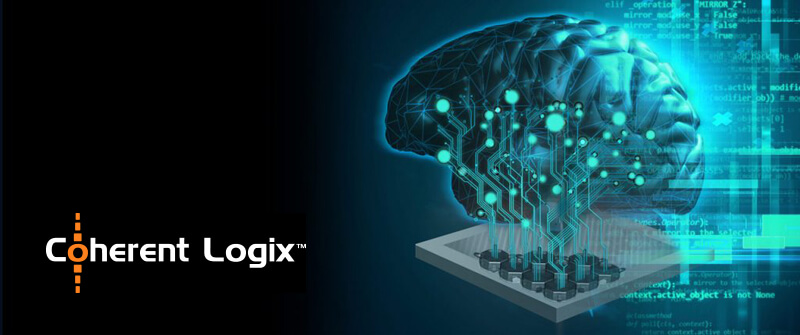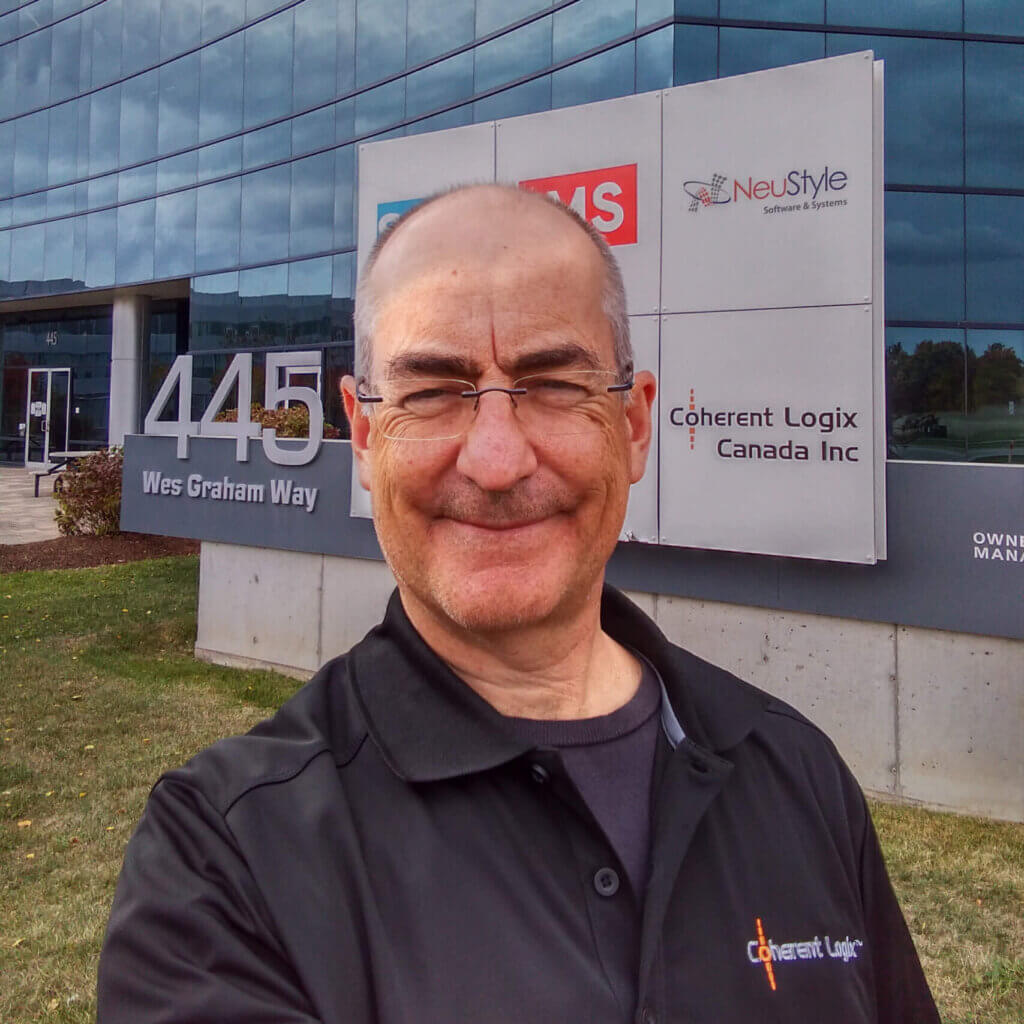How the Accelerator Centre is making a global impact in the R+T Park
This spring, two major showcase events brought Waterloo’s innovation community together to celebrate a new wave of startups tackling challenges…

The technology that we rely on today – and that we’re building for the future – all have something familiar at their core – chips. From the alarm clock next to your bed to the connected camera on your front porch, modern chips and chipsets help turn magic into reality. Taking an idea and turning it into a product has considerable development costs, especially when building hardware products such as cameras, radios, and other internet of things (IoT) devices that require a specialized set of chips to make them work.
That’s all starting to change thanks to David Johnston Research + Technology Park tenant Coherent Logix’s work. Based out of Austin, Texas, Coherent Logix builds solutions that allow developers to write their code onto a single chip without the expensive cost of custom chip creation. We first spoke with Coherent Logix when they moved into their Waterloo office last October. Their office in the R+T Park is growing with several new positions open, so we decided to catch up with the team to learn more about what’s possible with their products.
RELATED: Coherent Logix Thinking Big with New Offices in R+T Park
What sets Coherent Logix’s chip apart is that it’s reprogrammable. This enables developers to do rapid prototyping in the same way hardware developers would use a 3D printer to try out different product designs. Having a reprogrammable chip makes it an excellent option for teams doing work with everything from 5G and wireless to advanced machine learning and computer vision.
One of the hallmarks of technology is miniaturization – making each generation of a product smaller and smaller. From the suitcase-sized mobile phones of the 1980s to the almost matchbook thin smartphones we use today, making technology smaller means reducing the size of its internal components. Coherent Logix’s technology allows engineers to combine the functions of multiple chips into one single chip. “We’re now engaging with a consumer electronics company who is looking for an application that’s going to replace two or three chips that they would normally buy,” said David Starks, Director, Wireless Software Engineering at Coherent Logix. “They see value in our chip so that they can get rid of three chips and do it all in one Coherent Logix chip. Bluetooth, WiFi, powerline communications – all in one package.”
The Coherent Logix chip allows developers to write in well-known embedded languages like C. “What attracted me to the company is that our chip is reprogrammable like a FPGA (field-programmable gate array) or DSP (digital signal processor), but you’re only paying for the semiconductor one time,” said Starks. “So you’ve kind of got the advantage of a smaller size and lower power, but with the reconfigurability of an FPGA or DSP chip.”
The power to reprogram and combine chips into one single chip opens up new opportunities for the company. One area of particular interest for Coherent Logix Senior System Architect, Eugene Mezhibovsky is computer vision.

We interact with computer vision systems daily – mainly through those CAPTCHAS we use to confirm we’re human beings when logging into a website. Computer vision is training machines to mimic what the human visual system does. That’s everything from identifying objects (crosswalks, bicycles, and traffic lights) to being able to focus and track objects in motion. In Waterloo, one of the primary uses of computer vision in research is for autonomous vehicles. The University of Waterloo’s Autonomous Vehicle Research Intelligence Lab happens to be located just around the corner from the R+T Park. Computer vision is what an autonomous vehicle uses to see everything from the lines on a street to a fast-moving human who’s crossing the street without looking both ways.
“In computer vision, we’re trying to get into different spaces, but we’re focusing mainly now on use cases where you need the low power processing at the edge,” said Mezhibovsky. The edge Mezhibovsky referred to is a new paradigm in distributed computing where the actual computing takes place as close to the data source as possible. This is especially useful in scenarios where there is a requirement for complex data processing with limited bandwidth and power, such as wind turbine projects or remote monitoring of wildlife.
“One of the biggest challenges with computer vision at the edge is that to do any massive processing requires a very powerful processor which consumes a lot of energy,” said Mezhibovsky. In these use cases, cloud computing isn’t an option because there isn’t a strong cellular or WiFi connection available.
The ability to integrate different chips into a single chip allows for the creation of low power devices with some impressive functionality. The Coherent Logix HyperX™ chip lets developers integrate computer vision processing and wireless connectivity like 5G communications into a single chip.
This is where Coherent Logix’s technology comes in to shine. Mezhibovsky and the team are currently working with a camera manufacturer to have a computer vision processing application written into the Coherent Logix reprogrammable chip. In this example, the system doesn’t need to send large amounts of data back to the cloud since the processing is done in the camera itself. “Let’s say maybe the image coming from the camera needs to be stabilized. Maybe you need to encode the video for later on – all of that can happen on the edge device with our processor,” said Mezhibovsky. “The customer isn’t limited to whatever blocks have been integrated into the processor.”
“The customer isn’t limited to whatever blocks have been integrated into the processor. You design basically a single piece of hardware, and depending on your environment, or where you integrate it, you can load different code to run on it.”
Eugene Mezhibovsky, Senior System Architect, Coherent Logix
Combining multiple components into a single chip also enables customers to customize and reconfigure hardware as needed. “Let’s say, tomorrow, you move to a different area and you don’t have 5G. You can reconfigure the computational resources that were reserved for 5G and re-allocate them to run a WiFi modem,” added Mezhibovsky. “You design basically a single piece of hardware, and depending on your environment, or where you integrate it, you can load different code to run on it.”
The technology is creating a paradigm shift in the way developers are looking at real-world problems. “Today, if you go to an application developer, they don’t try to program embedded C like we do for our HyperX processor. They use things such as TensorFlow and OpenCV that allow you to create applications at your PC,” Mezhibovsky said. “We allow them to take their programs and – with little effort – port them to the HyperX processor.”
Coherent Logix’s Waterloo team in the R+T Park focuses on the software for their product lines. Both Starks and Mezhibovsky have spent their careers in the field at companies including Nortel and BlackBerry. Today, Starks is continuing to grow the Waterloo team with University of Waterloo co-op students and open positions for DSP software engineers and more. “I had a call with my VP of engineering and he’s really pleased with what’s coming out of the team here in Canada,” said Starks. “He really is seeing us as the area to grow.”
Visit their website to learn more opportunities at Coherent Logix.